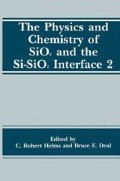Abstract
Oxygen fixation during dry oxidation of silicon was investigated using 18O labelling. We found that the amount of oxygen fixed near the outer surface of the oxide was not notably influenced by the silicon oxidation rate at the Si-SiO2 interface. To show this, we oxidized in 18O2 nitrogen-implanted Si16O2-Si structures (for which interfacial oxidation is inhibited) and unimplanted Si16O2-Si structures. We compared 18O fixation near the outer surface in both cases.
Access this chapter
Tax calculation will be finalised at checkout
Purchases are for personal use only
Preview
Unable to display preview. Download preview PDF.
References
Amsel, G., Nadai, J.P., d’Artemare, E., David, D., Girard, E., and Moulin, J., 1971, Microanalysis by the direct observation of nuclear reactions using a 2 MeV Van de Graaff, Nucl. Instrum. Methods 92:481.
Battistig, G., Amsel, G., d’Artemare, E., and Vickridge, Y., 1992, A very narrow resonance in 18O(p,a)15N near 150 keV. Application to isotopic tracing. II. High resolution depth profiling of 180, Nucl. Instrum. Methods B66:1.
Ganem, J J., 1992, Mécanismes de croissance de diélectriques par nitruration et par oxydation thermiques rapides du silicium, Thèse de l’Université Paris 7.
Habraken, F.H.P.M., Kuiper, A. E. T., and Tamminga, Y., 1982, Thermal nitridation of silicon dioxide films, J. Appl. Phys. 53:10.
Josquin, W J.M J., and Tamminga, Y., 1982, The oxidation inhibition in nitrogen-implanted silicon, J. Electrochem. Soc. 129:1803.
Kim, M J., and Ghezzo, M., 1984, Characterization of implanted nitride for VLSI applications, J. Electrochem. Soc. 131:1934.
Lorenz-Wirzba, H., Schmalbrock, P., Trautvetter, H.P., Wiescher, M., Rolfs, C, and Rodney, W.S., 1979, The 18O(p,α)15N reaction at stellar energies, Nucl Phys. A313:346.
Murarka, S.P., Chang, C.C., and Adams, A.C., 1979, Thermal nitridation of silicon in ammonia gas: composition and oxidation resistance of the resulting films, J. Electrochem. Soc. 126:996.
Raider, S.I., Gdula, R.A., and Petrak, J.R., 1975, Nitrogen reaction at a silicon-silicon dioxide interface, Appl. Phys. Lett. 27:150.
Raider, S.I., Herd, S.R., and Walkup, R.E., 1991, SiO2 film decomposition reaction initiated by carbon impurities located at a Si-SiO>2 interface, Appl. Phys. Lett. 59:2424.
Raider, S.I., 1992, Carbon impurities at Si-SiO2 interface, This meeting (Second Symposium on the Physics and Chemistry of SiO 2 and the Si-SiO 2 interface).
Rigo S., 1988, Sioxidation mechanisms as studied by oxygen tracer methods, in “The Physics and Chemistry of SiO2 and the Si-SiO2 Interface,” C.R. Helms and B.E. Deal, ed., Plenum Press, New York.
Rochet, F., 1981, Etude par traçage isotopique à loxygene 18 des mécanismes de transport atomique dans les couches minces d’oxyde de silicium et d’oxyde de tantale sur silicium, Thèse de Doctorat de 3 è cycle de lUniversité Paris 6.
Rochet, F., Agius, B., and Rigo, S., 1984, An 18O study of the oxidation mechanism of silicon in dry oxygen,J. Electrochem. Soc. 131:914.
Schott, K., Hofmann, K.C., and Schultz M., 1988, Blocking of silicon oxidation by low-dose nitrogen implantation, Appl. Phys. A45:73.
Trimaille, I., and Rigo S., 1989, Use of 18O isotopic labelling to study thermal dry oxidation of silicon as a function of temperature and pressure, Appl. Surf. Science 39:65.
Ziegler, J.F., Biersack, J.P., Cuomo, G., 1984–1989, The stopping and range of ions in matter, TRIM-89 code.
Author information
Authors and Affiliations
Editor information
Editors and Affiliations
Rights and permissions
Copyright information
© 1993 Springer Science+Business Media New York
About this chapter
Cite this chapter
Trimaille, I., Raider, S.I., Ganem, JJ., Rigo, S., Penebre, N.A. (1993). Use of 18O Labelling to Study Growth Mechanisms in Dry Oxidation of Silicon. In: Helms, C.R., Deal, B.E. (eds) The Physics and Chemistry of SiO2 and the Si-SiO2 Interface 2. Springer, Boston, MA. https://doi.org/10.1007/978-1-4899-1588-7_2
Download citation
DOI: https://doi.org/10.1007/978-1-4899-1588-7_2
Publisher Name: Springer, Boston, MA
Print ISBN: 978-1-4899-1590-0
Online ISBN: 978-1-4899-1588-7
eBook Packages: Springer Book Archive

